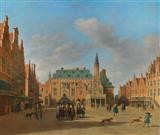Gerrit Berckheyde
(Haarlem 1638–1698)
The Grote Markt in Haarlem with the town hall,
oil on canvas, 53.3 x 62.5 cm, framed
Literature:
C. Lawrence, Gerrit Berckheyde, Doornspijk 1991, p. 31, note 10g
Exhibited:
Paris, Musée des Arts Decoratifs, La Vie en Hollande au XVIIe siècle, 11 January – 20 March 1967, no. 26
In 1660 Gerrit Berckheyde joined the Haarlem painters’ guild, painting primarily topographical views of squares and streets. He was the younger brother and pupil of Job Berckheyde, with whom he shared a studio. He painted views of Amsterdam, The Hague, and German towns. Although he had probably never visited Italy, his oeuvre also comprises views of Rome. However, most of his works depict the Grote Markt in his native town of Haarlem. He always had a preference for open urban spaces and their hustle and bustle, a distinct feature of his art being the reproduction of architecture true to detail. The modernity of individual views by his hand, still perceptible today, results from Berckheyde’s skilful play with light and shadow, which is reminiscent of Saenredam’s church interiors. One of the artist’s special talents was his clever choice of perspective that even gave the local population a chance to take a fresh look at a familiar place. With his views of towns, Berckheyde followed in the tradition of such important architectural and topographical painters as Emanuel de Witte or Pieter Jansz. Saenredam, who contributed to establishing the veduta as a genre in its own right. The town and thus urban space presented as a stage instead of a backdrop for narrative elements was also a symptom of the growing interest in topographical landmarks by which the Low Countries sought to exhibit their political relevance.
View it on
Estimate
Time, Location
Auction House
(Haarlem 1638–1698)
The Grote Markt in Haarlem with the town hall,
oil on canvas, 53.3 x 62.5 cm, framed
Literature:
C. Lawrence, Gerrit Berckheyde, Doornspijk 1991, p. 31, note 10g
Exhibited:
Paris, Musée des Arts Decoratifs, La Vie en Hollande au XVIIe siècle, 11 January – 20 March 1967, no. 26
In 1660 Gerrit Berckheyde joined the Haarlem painters’ guild, painting primarily topographical views of squares and streets. He was the younger brother and pupil of Job Berckheyde, with whom he shared a studio. He painted views of Amsterdam, The Hague, and German towns. Although he had probably never visited Italy, his oeuvre also comprises views of Rome. However, most of his works depict the Grote Markt in his native town of Haarlem. He always had a preference for open urban spaces and their hustle and bustle, a distinct feature of his art being the reproduction of architecture true to detail. The modernity of individual views by his hand, still perceptible today, results from Berckheyde’s skilful play with light and shadow, which is reminiscent of Saenredam’s church interiors. One of the artist’s special talents was his clever choice of perspective that even gave the local population a chance to take a fresh look at a familiar place. With his views of towns, Berckheyde followed in the tradition of such important architectural and topographical painters as Emanuel de Witte or Pieter Jansz. Saenredam, who contributed to establishing the veduta as a genre in its own right. The town and thus urban space presented as a stage instead of a backdrop for narrative elements was also a symptom of the growing interest in topographical landmarks by which the Low Countries sought to exhibit their political relevance.



